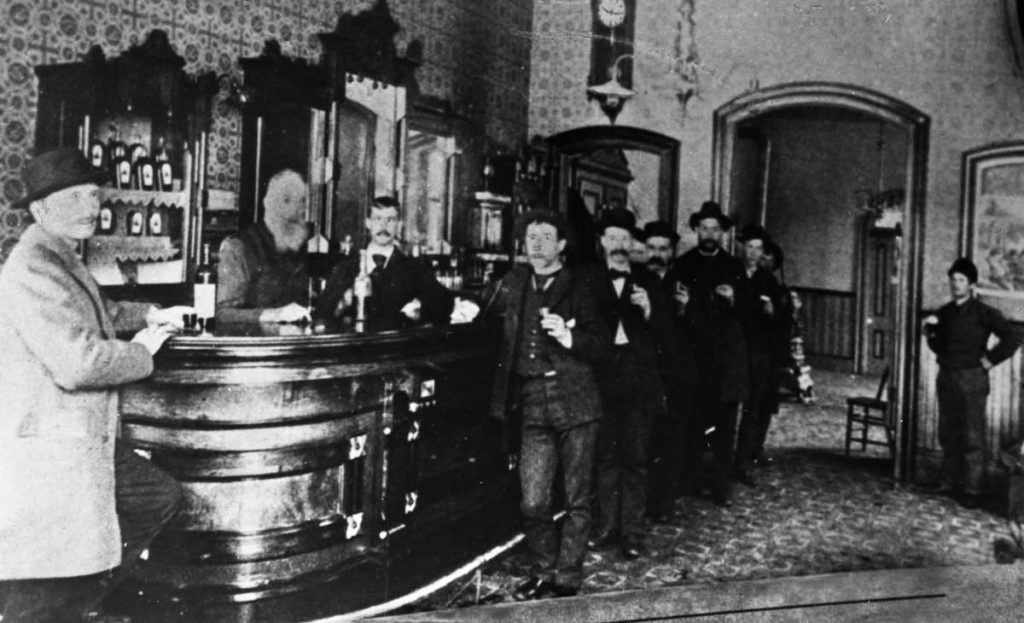Alcohol was a famous component of daily life in the old American West, and the West’s miners partook in its consumption with as much enthusiasm as anyone. Alcohol served to “relieve the aches and pains from long hours spent…digging in underground tunnels,” and in developing towns alcohol was often safer and cheaper than other beverages, like water and milk.[i] When mines began springing up in Park City in the 1870s, the miners who arrived in town brought alcohol and its influence with them.
The proliferation of booze in the newborn mining town was almost unbelievably quick; In 1880, when Park City’s population was recorded in the United States census as numbering only 1,542 residents (though there are other counts which pin the number of Parkites as high as 3,500), it was reported that almost two dozen saloons had already sprung up, supporting the lifestyles of the increasing number of drunks.[ii] The large number of saloons promoted fierce competition between the businesses’ owners, with sometimes violent consequences: in 1875, a saloon keeper named Nelson fatally injured a rival, James Wheyland, in a drunken brawl.[iii] The saloons’ patrons weren’t any better behaved than their owners, and this killing was far from the only notable incidence of drunken behavior in Park City’s early days.
The Park Record took to decrying the influence of “King Alcohol,” and it would publish accounts of drunken behavior with disapproval. Editors despaired at the frequency of such drunk and disorderly conduct, referring to one instance involving a shotgun being sold to fund a night of drinking as an “old story with some new clothes on.”[iv] The paper lectured readers in 1880 “to slack up on the beverage,” employing a morality tale about an anonymous “well-to-do citizen” being fined $23 for drunkenly breaking into a home and continuing to drink inside.[v]
The paper also printed several critical profiles of drinkers during the last years of the nineteenth century, with one describing the average beer drinker as “incapable of resisting disease.”[vi] It also printed supposed cures for alcoholism, including the suggestion that “lucious [sic] fruits” like oranges could be consumed, “[diminishing] the desire for drink…until at last it is completely crucified.”[vii]

Credit: Park City Historical Society & Museum, Roslyn Stewart Collection
This moralizing on the part of local newspapermen wasn’t entirely unjustified. Judging by court reports printed in the Park Record during the mid-1880s, public drunkenness was the most commonly punished crime in town, with offenders cited for such infractions as being “plain drunk.”[viii] In 1886, in one of many memorable incidents, a drunk youth named James Burns chased a companion, James Clark, into an alley and shot at him four times, though he missed each time. This occurred at dawn, and Clark was charged with drunkenness as well.[ix]
Certain groups of Parkites were stereotyped as being particularly prone to drinking, namely the Irish. Many Irish immigrants arrived in Park City in the later nineteenth century, employed by the railroads and mines.[x] Despite the fact that the Irish were a large, influential cultural group in town, they were still subjected to stereotyping by their neighbors. At the time of Park City’s founding, many Americans believed that the Irish and Irish-Americans “had a significant weakness for drink,” and this belief was prevalent among non-Irish Parkites, as well.[xi] Amid the Park Record’s many condemnations of drunkenness, it also printed a joke about an Irishman named O’Shaughnessy who was so inebriated that his breath ignited and blew him up when he attempted to blow out a candle.[xii] Later, it reprinted another joke, suggesting that Irish soldiers need not be paid, as they would follow orders as long as they were promised a drink upon completing them.[xiii]
The Park City Museum is hosting a lecture titled “Behind the Bars and Booze of Park City” given by High West Distillery co-founder Jane Perkins on Wednesday, July 24 from 5-6 p.m. at the Museum’s Education and Collections Center located at 2079 Sidewinder Drive.
[i] Jeremy Agnew, Alcohol and Opium in the Old West: Use, Abuse, and Influence (Jefferson, North Carolina: Mcfarland & Company, 2014), 11–12, https://books.google.com/books?id=tStvAQAAQBAJ&lpg=PP1&ots=LD2Bjr5t5q&dq=miners%20and%20alcohol%201800s%20american%20west&lr&pg=PP1#v=onepage&q&f=false.
[ii] Riley Moffatt, Population History of Western U.S. Cities & Towns, 1850–1990 (Lanham, Maryland: Scarecrow Press, 1996), 309; David Hampshire, Martha Sonntag Bradley, and Allen Roberts, A History of Summit County (Salt Lake City: Utah State Historical Society, 1998) 96–98.
[iii] Ogden Junction, July 13, 1875, 2, https://newspapers.lib.utah.edu/ark:/87278/s64n3k9h/23763763.
[iv] “Crossouts,” Park Record, July 16, 1881, 3, https://newspapers.lib.utah.edu/ark:/87278/s6p02690/23113786.
[v] “Costly Beer,” Park Record, June 19, 1880, 4, https://newspapers.lib.utah.edu/ark:/87278/s6xh3pvp/23113777.
[vi] “The Beer Drinker,” Park Record, September 28, 1889, 4, https://newspapers.lib.utah.edu/ark:/87278/s6g74gxp/8307097.
[vii] “Fruit Versus Alcohol,” Park Record, November 4, 1899, 2, https://newspapers.lib.utah.edu/ark:/87278/s6r79hh3/8328728.
[viii] “Court Reports,” Park Record, September 6, 1884, 4, https://newspapers.lib.utah.edu/ark:/87278/s6349nj8/8293916.
[ix] “Court Cullings,” Park Record, June 26, 1886, 3, https://newspapers.lib.utah.edu/ark:/87278/s6gx5dp0/8297881.
[x] Carter Williams, “Looking Back at Irish History in Utah,” KSL, March 16, 2017, https://www.ksl.com/article/43517003/looking-back-at-irish-history-in-utah.
[xi] Alice Mauger, “The Rise, Fall, and Debunking of the ‘Drunken Irish’ Stereotype,” Raidió Teilifís Éireann, March 11, 2020, https://www.rte.ie/brainstorm/2020/0310/1121342-drunken-irish-stereotype/.
[xii] “Pat’s Pledge,” Park Record, January 28, 1882, 3, https://newspapers.lib.utah.edu/ark:/87278/s6tb292s/8287638.
[xiii] “Well Fed Fighters,” Park Record, August 27, 1898, 1, https://newspapers.lib.utah.edu/ark:/87278/s6xs6xns/8329490.